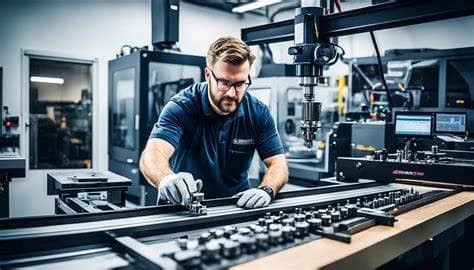Introdução
In today’s world of precision manufacturing, CNC programming is the backbone of modern machining. Without it, CNC (Computer Numerical Control) machines would be nothing more than expensive, idle equipment. CNC programming bridges the gap between digital design and physical production, transforming raw materials into complex, high-precision components used in aerospace, automotive, and medical industries.
But what exactly is CNC programming, and why is it so crucial in modern manufacturing? This article explores the fundamentals, types, benefits, and challenges of CNC programming, providing valuable insights into this essential skill.
O que é CNC Programming?
CNC programming is the process of writing and inputting instructions into a CNC machine to control its movements and operations. These instructions, written in G-code or M-code, tell the machine how to cut, drill, mill, or turn materials into the desired shape.
With CNC programming, manufacturers can produce parts with unmatched precision, speed, and consistency. Unlike manual machining, where human error can affect the outcome, CNC programming ensures every part meets exact specifications.
Types of CNC Programming
- Manual G-Code Programming
- Involves writing G-code directly, giving operators full control over the machine.
- Used for simple operations or fine-tuning complex machining processes.
- CAM Software Programming
- Computer-Aided Manufacturing (CAM) software generates CNC programming code automatically from a 3D model.
- Ideal for complex parts with intricate geometries.
- Conversational Programming
- User-friendly interface allows operators to input parameters without extensive G-code knowledge.
- Common in smaller machine shops for simple machining tasks.
Key Components of CNC Programming
G-Code & M-Code
- G-code controls movements (e.g., positioning, cutting, and tool changes).
- M-code controls auxiliary functions (e.g., coolant activation and spindle speed).
Tool Path Optimization
- Efficient CNC programming minimizes unnecessary movements to improve speed and reduce tool wear.
Work Coordinate System (WCS)
- Defines the machine’s reference points to ensure accuracy in multi-axis machining.
Error Handling & Debugging
- Simulations and dry runs help detect and correct errors before actual production.
Advantages of CNC Programming
Unmatched Precision & Consistency
With CNC programming, every part is manufactured with the same exact measurements, eliminating human error.
High Efficiency & Productivity
Automated machining allows for 24/7 operation, reducing downtime and increasing output.
Flexibility for Complex Designs
Advanced CNC programming makes it possible to create highly complex geometries that are difficult or impossible to achieve with manual machining.
Cost-Effective Mass Production
Once a program is optimized, it can be reused indefinitely, reducing labor costs and material waste.
Common Challenges in CNC Programming
Programming Errors
Incorrect G-code can lead to tool crashes, scrap materials, and costly machine damage.
Machine-Specific Variations
Different CNC machines may require adjustments in CNC programming to accommodate unique capabilities.
Skill Gap
Mastering CNC programming requires technical expertise, but training programs and AI-driven CAM software are making it more accessible.
Future Trends in CNC Programming
AI & Machine Learning Integration
AI-driven CNC programming can optimize tool paths, predict wear, and reduce material waste.
Cloud-Based CNC Control
Remote access and monitoring of CNC machines will improve efficiency in global manufacturing.
Fabrico de híbridos
Combining CNC programming with additive manufacturing (3D printing) will enable new possibilities in rapid prototyping and custom production.
Conclusão
From precision aerospace components to custom automotive parts, CNC programming is at the heart of modern machining. It transforms digital designs into reality with unparalleled accuracy and efficiency. As technology continues to evolve, mastering CNC programming will remain an invaluable skill for manufacturers looking to push the boundaries of innovation.
